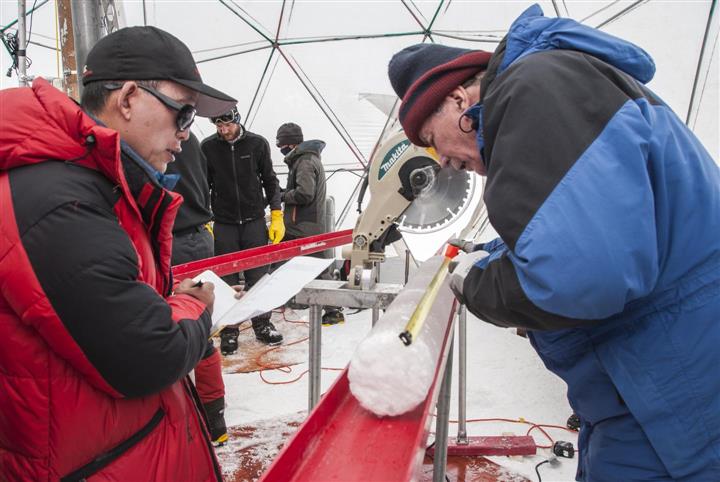
Yao Tandong, left, and Lonnie Thompson, right, process an ice core drilled from the Guliya Ice Cap in the Tibetan Plateau in 2015. The ice held viruses nearly 15,000 years old, a new study has found. Image courtesy Lonnie Thompson, The Ohio State University
New York, July 21
Scientists have found viruses nearly 15,000-years-old in two ice samples taken from the Tibetan Plateau in China. Most of those viruses, which survived because they had remained frozen, are unlike any viruses that have been cataloged to date.
The findings, published in the journal Microbiome, may help understand how viruses have evolved over centuries. For this study, the scientists also created a new, ultra-clean method of analysing microbes and viruses in ice without contaminating it.
"These glaciers were formed gradually, and along with dust and gases, many, many viruses were also deposited in that ice," said lead author Zhi-Ping Zhong, a researcher at The Ohio State University's Byrd Polar and Climate Research Centre who also focuses on microbiology.
"The glaciers in western China are not well-studied, and our goal is to use this information to reflect past environments. And viruses are a part of those environments," Zhong added.
The team analysed ice cores taken in 2015 from the Guliya ice cap in western China. The cores are collected at high altitudes -- the summit of Guliya, where this ice originated, is 22,000 feet above sea level.
When they analysed the ice, they found genetic codes for 33 viruses. Four of those viruses have already been identified by the scientific community. But at least 28 of them are novel. About half of them seemed to have survived at the time they were frozen not in spite of the ice, but because of it.
"These are viruses that would have thrived in extreme environments," said Matthew Sullivan, Professor of microbiology at Ohio State.
"These viruses have signatures of genes that help them infect cells in cold environments -- just surreal genetic signatures for how a virus is able to survive in extreme conditions," he added.
Four of the viruses in the Guliya ice cap cores had previously been identified and were from virus families that typically infect bacteria. The researchers found the viruses in concentrations much lower than have been found to exist in oceans or soil.
The analysis showed that the viruses likely originated with soil or plants, not with animals or humans, based on both the environment and the databases of known viruses. IANS
Join Whatsapp Channel of The Tribune for latest updates.



























